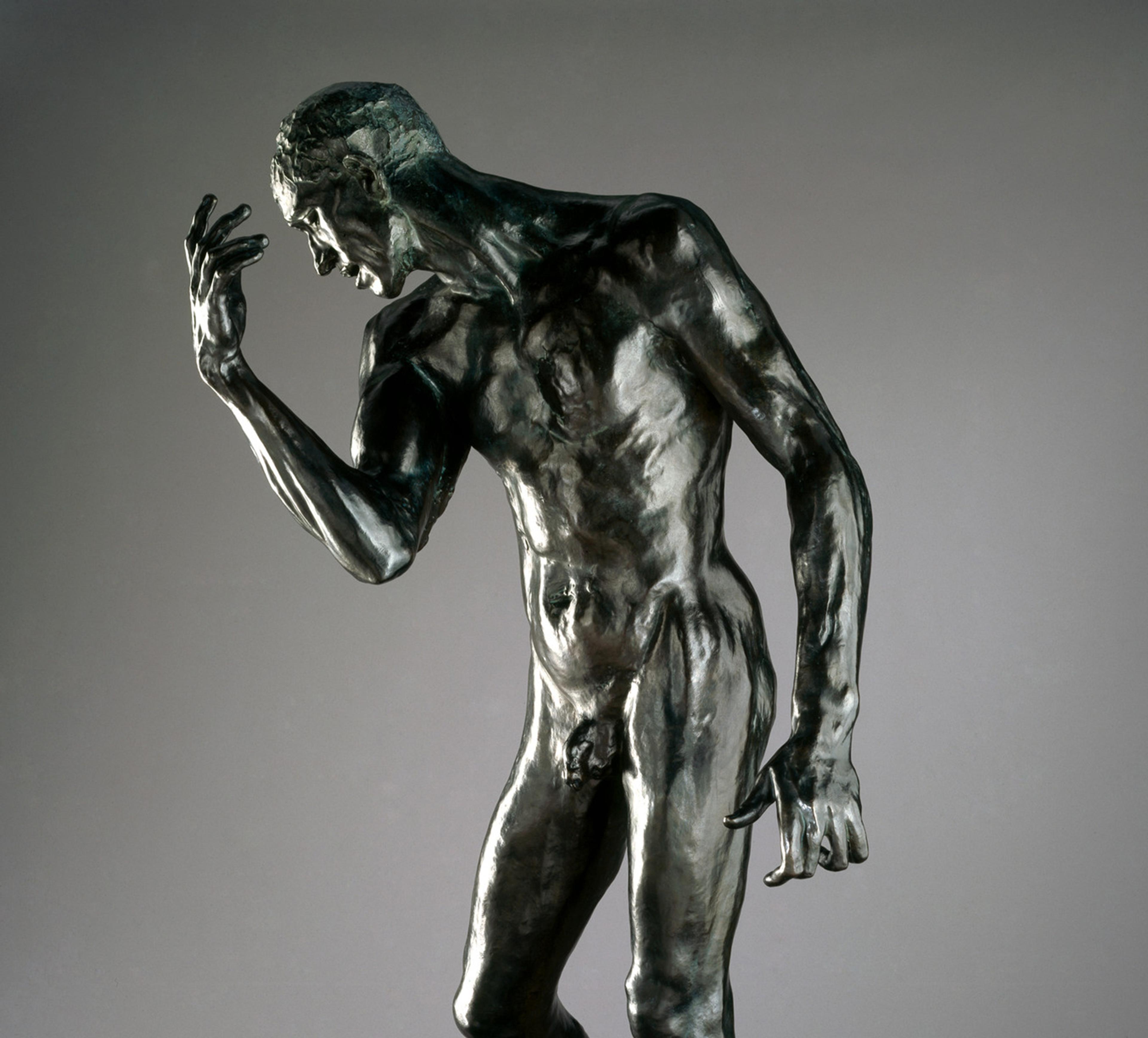The Age of Bronze, medium-sized model, first reduction (L'Age d'airain, première réduction)

Brooklyn Museum photograph
Object Label
This male nude is one of Auguste Rodin’s most celebrated and enigmatic subjects. First called <i>The Vanquished</i>, it was interpreted as emblematic of France’s heroism and suffering in the Franco-Prussian War of 1870–71. When Rodin decided to remove the lance the model posed with, he also eliminated any explicit narrative symbols in favor of simply highlighting the sensuality and emotional potential of the human body. He retitled it<i> The Age of Bronze</i>, suggesting that the figure, with its now mysterious gestures, evoked a moment of awakening into a new consciousness. At the 1877 Salon, the naturalism of the life-size plaster led to accusations that Rodin had made a cast directly from the “commonplace” body of his model. <br />
<br />
The half-life-size version seen here was probably first produced in 1903–4 in response to popular demand for a smaller-format edition.
Caption
Auguste Rodin French, 1840–1917. The Age of Bronze, medium-sized model, first reduction (L'Age d'airain, première réduction), 1876 (reduction probably 1903–04); cast 1967. Bronze, 41 1/4 x 15 x 13 in., 65 lb. (104.8 x 38.1 x 33 cm, 29.48kg) mount (including clips): 41 1/2 × 13 × 12 in. (105.4 × 33 × 30.5 cm). Brooklyn Museum, Gift of B. Gerald Cantor, 68.49. Creative Commons-BY (Photo: Brooklyn Museum, 68.49_SL1.jpg)
Tags
Gallery
Not on view
Gallery
Not on view
Artist
Title
The Age of Bronze, medium-sized model, first reduction (L'Age d'airain, première réduction)
Date
1876 (reduction probably 1903–04); cast 1967
Geography
Place made: France
Medium
Bronze
Classification
Dimensions
41 1/4 x 15 x 13 in., 65 lb. (104.8 x 38.1 x 33 cm, 29.48kg) mount (including clips): 41 1/2 × 13 × 12 in. (105.4 × 33 × 30.5 cm)
Signatures
Base, proper left: "A. Rodin"
Markings
Back of base:".Georges Rudier./.Fondeur. Paris." Base, bottom edge: "© by Musée Rodin 1967"
Credit Line
Gift of B. Gerald Cantor
Accession Number
68.49
Rights
Creative Commons-BY
You may download and use Brooklyn Museum images of this three-dimensional work in accordance with a Creative Commons license. Fair use, as understood under the United States Copyright Act, may also apply. Please include caption information from this page and credit the Brooklyn Museum. If you need a high resolution file, please fill out our online application form (charges apply). For further information about copyright, we recommend resources at the United States Library of Congress, Cornell University, Copyright and Cultural Institutions: Guidelines for U.S. Libraries, Archives, and Museums, and Copyright Watch. For more information about the Museum's rights project, including how rights types are assigned, please see our blog posts on copyright. If you have any information regarding this work and rights to it, please contact copyright@brooklynmuseum.org.
Frequent Art Questions
How did Rodin make these sculptures?
 Rodin used the "sand casting" method. He would have created his intended form in clay, then built a mould around it using a mixture of special sand, salt, and a binding agent. When the mould was ready, he would remove the clay from the center and then pour liquid bronze into the mould. Unlike other bronze casting techniques available at the time, sand casting allows for the creation of multiples.
Rodin used the "sand casting" method. He would have created his intended form in clay, then built a mould around it using a mixture of special sand, salt, and a binding agent. When the mould was ready, he would remove the clay from the center and then pour liquid bronze into the mould. Unlike other bronze casting techniques available at the time, sand casting allows for the creation of multiples.Why do you have so many Rodin sculptures?
We received many of the Rodin works currently on view as a gift from the Cantor Foundation in 1980s. The Cantor Foundation is interested creating opportunities to further explore the works of Rodin and his contemporaries.This doesn't seem like a typical Rodin.
 Great observation. This sculpture, "The Age of Bronze" is very naturalistic and smooth. It shows that Rodin was perfectly capable of sculpting life-like figures—even if he rarely chose to do so. In general, Rodin valued energetic, expressive figures over anatomical correctness. When this work was first shown, critics accused Rodin of casting a model's body because it is so naturalistic!In fact, what he had done was study a single model over a period of eighteen months, observing his body and even its imperfections with incredible attention to detail. This bronze version is a reduced iteration of the life sized plaster that critics first saw in 1877.
Great observation. This sculpture, "The Age of Bronze" is very naturalistic and smooth. It shows that Rodin was perfectly capable of sculpting life-like figures—even if he rarely chose to do so. In general, Rodin valued energetic, expressive figures over anatomical correctness. When this work was first shown, critics accused Rodin of casting a model's body because it is so naturalistic!In fact, what he had done was study a single model over a period of eighteen months, observing his body and even its imperfections with incredible attention to detail. This bronze version is a reduced iteration of the life sized plaster that critics first saw in 1877.Nice
 So nice, in fact, that people actually thought that sculpture was fake at first because it was too perfect. Rodin first presented a life-size version that viewers thought was just a man covered in bronze, but Rodin was just really talented!
So nice, in fact, that people actually thought that sculpture was fake at first because it was too perfect. Rodin first presented a life-size version that viewers thought was just a man covered in bronze, but Rodin was just really talented!
Have information?
Have information about an artwork? Contact us at
